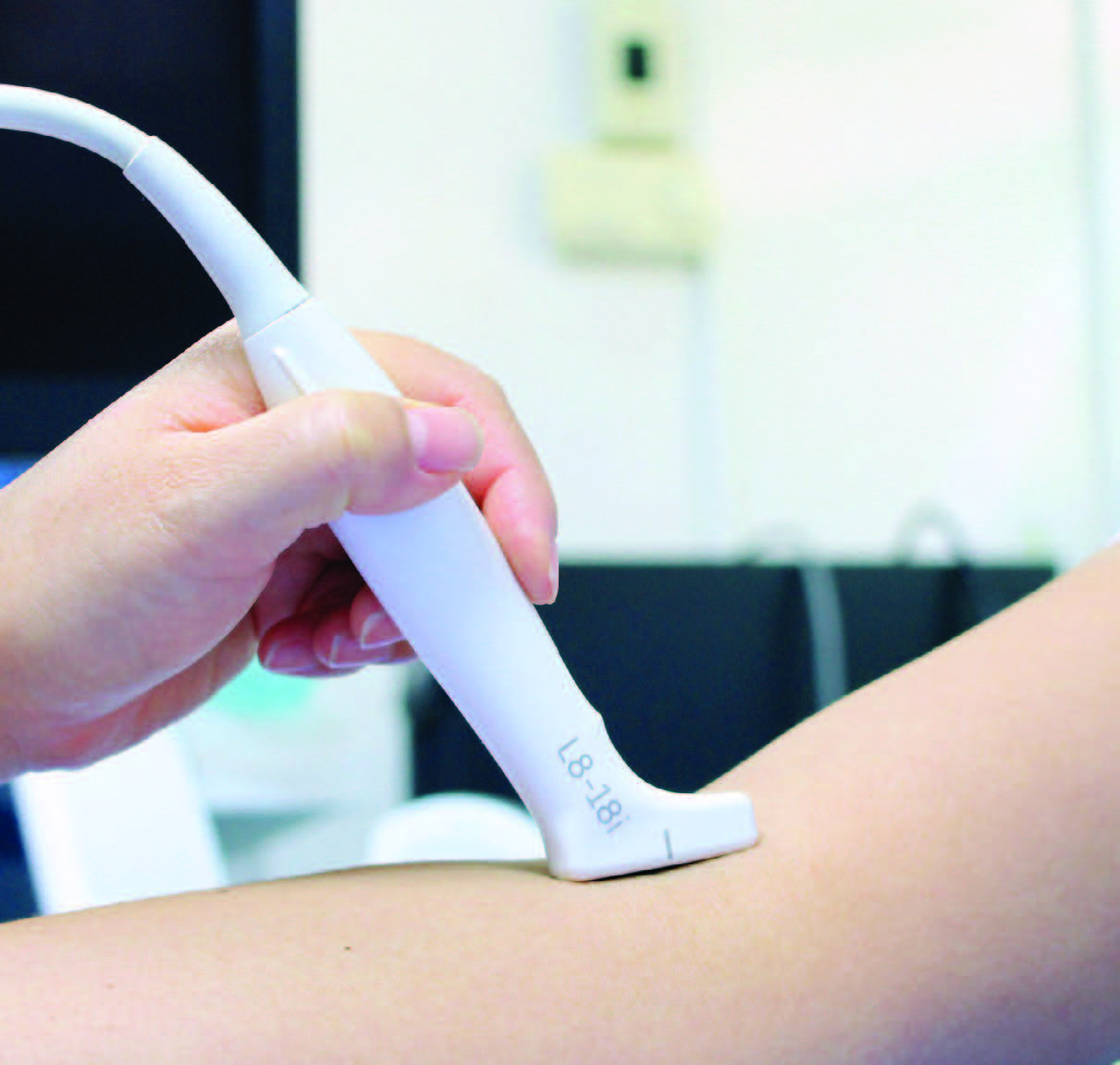Standardized protocols and education can improve patient safety, reduce costs, and enhance nursing practice.
Takeaways:
- Achieving peripheral I.V. access can be difficult, even for experienced clinicians.
- Approximately 90% of hospitalized patients require some form of peripheral venous access, but study suggests that up to 50% of children and 35% of adults have difficult venous access.
- Evidence-based ultrasound guidance can lower costs, speed diagnosis, reduce patient discomfort, and alleviate nurse frustration.
Establishing peripheral I.V. access is an essential, high-priority nursing procedure. However, access sometimes can be difficult to obtain even for experienced clinicians. Recently, the evidence-based ultrasound-guided short peripheral catheter (USGSPC) insertion method has been established as effective when caring for patients with difficult venous access. The success rate is high, and the added advantages of improved accuracy and more timely insertion increase patient safety and satisfaction. However, recent research demonstrates that USGSPC insertion hasn’t been widely adopted. This may be due to a lack of awareness or an absence of organizational protocols for training and use.
To increase adoption of USGSPC, nurses first need to understand its benefits and use. They will then be well positioned to integrate the method into nursing education and implement it in clinical practice.
Why USGSPC?
According to Hunter and colleagues, approximately 90% of hospitalized patients require some form of peripheral venous access, yet this procedure can be difficult to complete, with at least one study (Whalen and colleagues) suggesting that up to 50% of children and 35% of adults have difficult venous access. (See Difficult access.)
When performed properly, short peripheral catheter (SPC) insertion is a safe procedure with minimal serious risks. When insertion can’t be achieved using traditional direct visualization, palpation, or landmark-based techniques, ultrasound provides a high rate of success with substantial benefits for both patients and nurses.
Patients with difficult venous access include those with:
- obesity
- a history of I.V. drug use
- multiple chronic illnesses.
Some pathophysiologic changes also may decrease the ability to use traditional visualization when inserting a short peripheral catheter. These conditions include:
- edema
- hypovolemia
- vascular pathology.
Two out of every five patients require multiple attempts to achieve I.V. access, sometimes taking 30 minutes or more to complete. The result can be:
- patient pain and discomfort
- lack of blood specimens
- delayed diagnosis and treatment
- decreased nurse productivity
- increased supply costs
- increased likelihood of using a more expensive high-risk procedure, such as central venous catheter (CVC) insertion.
CVC risks
Inserting and maintaining a CVC can be dangerous, exposing patients to serious complications including:
- catheter-associated bloodstream infections
- large vessel injuries
- hematomas
- cardiac arrhythmias
- venous air embolisms
- pneumothorax.
USGSPC insertion benefits
The 2016 Infusion Therapy Standards of Practice state that no more than two attempts at SPC insertion should be made per clinician, with no more than four total attempts. Quickly and efficiently obtaining I.V. access using ultrasound guidance in patients with difficult venous access reduces the number of attempts, increases success rates, and decreases insertion pain. It also reduces care delays, provides cost and time savings, improves patient satisfaction, reduces nurse and provider frustration, and attenuates the complications of multiple attempts or more invasive procedures (Miles and colleagues and Shokoohi and colleagues report that USGSPC insertion performed by trained nurses can decrease the need for central venous catheter [CVC] placement by as much as 74% to 80%).
Nursing implications
In most healthcare organizations, a provider, specialty trained vascular access nurse, or other ultrasound-proficient healthcare professional uses the USGSPC procedure to obtain cannulation only after a nurse is unsuccessful with traditional techniques. However, evidence shows that with structured training, nurses can effectively use the USGSPC method (Feinsmith and colleagues report consistent success rates as high as 96%). In a study by Edwards and Jones, nine out of 10 nurses agreed that dedicated training adequately prepared them to use ultrasound guidance for insertion, and seven out of 10 found actual placement to be easy. According to Bahl and colleagues, nurses using the USGSPC technique after completing training were more likely to achieve cannulation compared to nurses using standard visualization and palpation, and the time required to complete the procedure was shortened.
Many large academic healthcare organizations have dedicated vascular access teams composed of experts in difficult venous access. These multidisciplinary teams, which frequently include nurses trained in USGSPC insertion, identify patients with difficult venous access and intervene early to establish timely insertion. Across the United States, state boards of nursing do not require board certification for vascular access nurse specialists; however, many state laws do require that healthcare organizations have written policies and procedures to ensure that nurses demonstrate and maintain competency. With increased access to educational resources and technology (guided by organizational policies and procedures), USGSPC insertion training that includes staff nurses who routinely obtain venous access could reasonably be achieved.
USGSPC implementation
The 2016 Infusion Therapy Standards of Practice state that only nurses who possess the appropriate skills and validated competencies should insert SPCs, but the literature reveals that even traditional SPC insertion education is inconsistent. To ensure nurses can efficiently, safely, and comfortably perform USGSPC insertion, enhanced organizational SPC curriculum should include standardized, evidence-based USGSPC training and use protocols. (See Education basics.) The protocols should encompass training expectations and curriculum, skills assessment and maintenance, and portable ultrasound equipment availability.
Guidelines and protocols are readily available to help facilitate implementing USGSPC insertion into nursing practice. Video tutorials, such as one published by The New England Journal of Medicine, demonstrate the technique. And a formal online training course for teaching and learning the USGSPC insertion technique is available at IvyLeagueNurse.com. With so many resources and evidence-based materials available, developing a structured hands-on training curriculum and obtaining proficiency in USGSPC insertion is attainable for nurses in all geographic areas and practice settings.
With basic education and hands-on practice with the ultrasound-guided short peripheral catheter insertion method, nurses can achieve a high level of I.V. access success. Nurse education and training should include:
- basic ultrasound knowledge, including how to operate the machine and identify venous structures
- knowledge of vascular anatomy and vessel selection
- an awareness of vein depth, catheter insertion angle, and catheter length to facilitate safe and effective insertion
- skills such as how to hold the probe, view the needle, and identify successful cannulation.
Spreading the word
Sufficient research exists to support USGSPC for patients with difficult venous access; however, many nurses still don’t use the technique. Nurses can take the lead in encouraging USGSPC implementation in practice so patients can reap the benefits.
Carrie A. Cromwell is a certified registered nurse anesthetist at the Central Texas Veterans Health Care System in Temple and a doctor of nursing practice student and Jonas Veterans Healthcare Scholar at the University of Alabama Capstone College of Nursing in Tuscaloosa. Alice L. March is a professor at the University of Alabama Capstone College of Nursing.
References
American Institute of Ultrasound in Medicine. AIUM practice parameter for the use of ultrasound to guide vascular access procedures. J Ultrasound Med. 2019;38(3):E4-E18.
Arnold K. Ultrasound guided peripheral IV insertion. IvyLeagueNurse.com. November 11, 2014. ivyleaguenurse.com/courses/Ultrasound_Guided_PIVs.pdf.
Bahl A, Pandurangadu AV, Tucker J, Bagan M. A randomized controlled trial assessing the use of ultrasound for nurse-performed IV placement in difficult access ED patients. Am J Emerg Med. 2016;34(10):1950-4.
Björkander M, Bentzer P, Schött U, Broman ME, Kander T. Mechanical complications of central venous catheter insertions: A retrospective multicenter study of incidence and risks. Acta Anaesthesiol Scand. 2019;63(1):61-8.
Chopra V, Kuhn L, Vaughn V, et al. Does certification in vascular access matter? An analysis of the PICC1 survey. Am J Nurs. 2017;117(12):24-34.
Dietrich CF, Horn R, Morf S, et al. US-guided peripheral vascular interventions, comments on the EFSUMB guidelines. Med Ultrason. 2016;18(2):231-9.
Edwards C, Jones J. Development and implementation of an ultrasound-guided peripheral intravenous catheter program for emergency nurses. J Emerg Nurs. 2018;44(1):33-6.
Feinsmith S, Huebinger R, Pitts M, Baran E, Haas S. Outcomes of a simplified ultrasound-guided intravenous training course for emergency nurses. J Emerg Nurs. 2018;44(2):169-75.
Gorski LA. The 2016 Infusion Therapy Standards of Practice. Home Healthc Now. 2017;35(1):10-8.
Gosselin É, Lapré J, Lavoie S, Rhein S. Cost-effectiveness of introducing a nursing-based programme of ultrasound-guided peripheral venous access in a regional teaching hospital. J Nurs Manag. 2017;25(5):339-45.
Haddadin Y, Regunath H. Central line associated blood stream infections (CLABSI). StatPearls. December 9, 2019. ncbi.nlm.nih.gov/books/NBK430891
Hunter MR, Vandenhouten C, Raynak A, Owens AK, Thompson J. Addressing the silence: A need for peripheral intravenous education in North America. J Assoc Vasc Access. 2018;23(3):157-65.
İsmailoğlu EG, Zaybak A, Akarca FK, Kiyan S. The effect of the use of ultrasound in the success of peripheral venous catheterisation. Int Emerg Nurs. 2015;23(2):89-93.
Joing S, Strote S, Caroon L, et al. Ultrasound-guided peripheral IV placement. NEJM. August 4, 2012. youtube.com/watch?v=-fduIjQ8EH4&t=6s
McCarthy ML, Shokoohi H, Boniface KS, et al. Ultrasonography versus landmark for peripheral intravenous cannulation: A randomized controlled trial. Ann Emerg Med. 2016; 68(1):10-8.
Miles G, Salcedo A, Spear D. Implementation of a successful registered nurse peripheral ultrasound-guided intravenous catheter program in an emergency department. J Emerg Nurs. 2012;38(4):353-6.
National Healthcare Safety Network. Central line-associated bloodstream infections (CLABSI). nhsn.cdc.gov/nhsntraining/courses/2018/C04
Oliveira L, Lawrence M. Ultrasound-guided peripheral intravenous access program for emergency physicians, nurses, and corpsmen (technicians) at a military hospital. Mil Med. 2016;181(3):272-6.
Pare JR, Pollock SE, Liu JH, Leo MM, Nelson KP. Central venous catheter placement after ultrasound guided peripheral IV placement for difficult vascular access patients. Am J Emerg Med. 2019;37(2):317-20.
Shokoohi H, Boniface K, McCarthy M, et al. Ultrasound-guided peripheral intravenous access program is associated with a marked reduction in central venous catheter use in noncritically ill emergency department patients. Ann Emerg Med. 2013;61(2):198-203.
Stolz LA, Stolz U, Howe C, Farrell IJ, Adhikari S. Ultrasound-guided peripheral venous access: A meta-analysis and systematic review. J Vasc Access. 2015;16(4):321-6.
Weiner SG, Sarff AR, Esener DE, et al. Single-operator ultrasound-guided intravenous line placement by emergency nurses reduces the need for physician intervention in patients with difficult-to-establish intravenous access. J Emerg Med. 2013;44(3):653-60.
Whalen M, Maliszewski B, Baptiste DL. Establishing a dedicated difficult vascular access team in the emergency department: A needs assessment. J Infus Nurs. 2017;40(3):149-54.



















1 Comment.
This is fantastic. One of the most stressful things for patient and nurse. A game-changer. Makes me want to go back to working in the hospital!